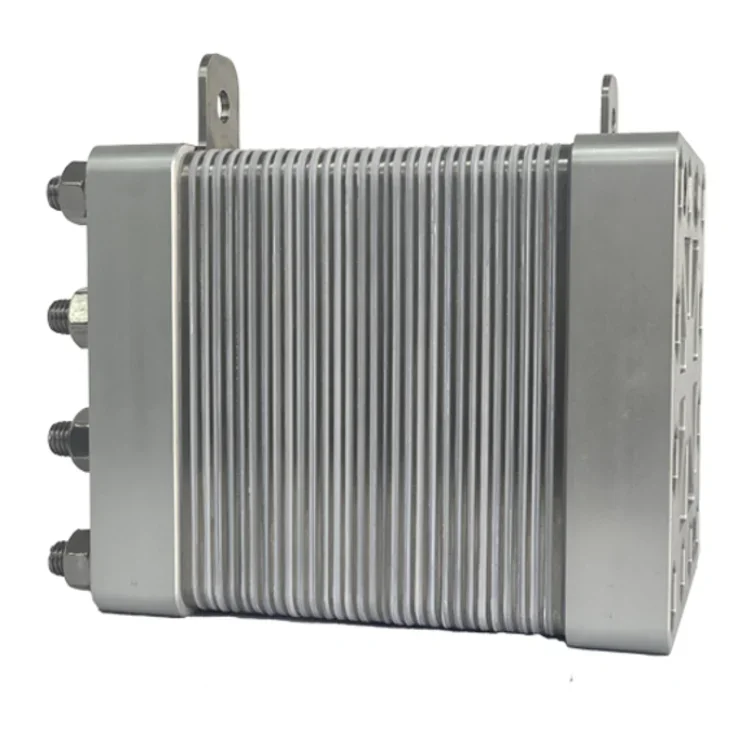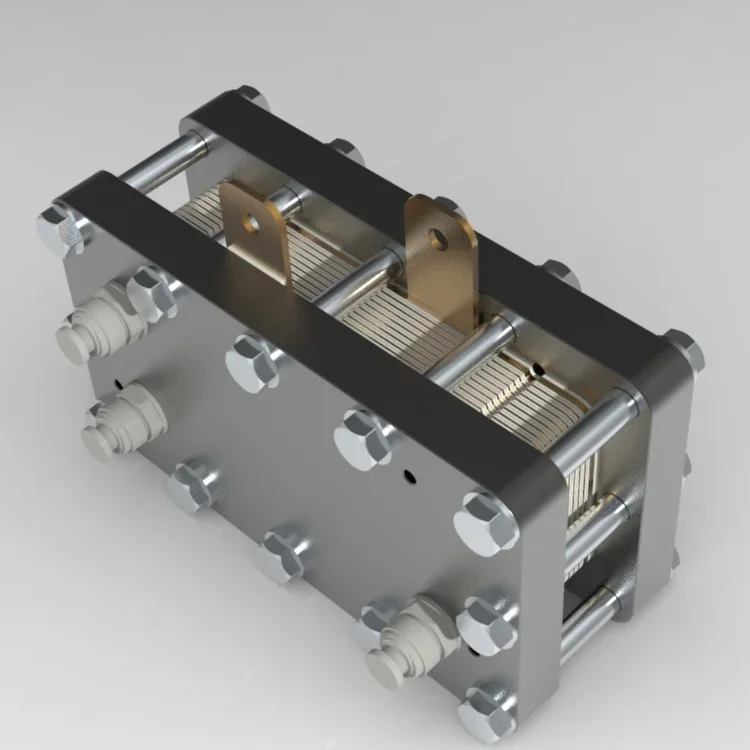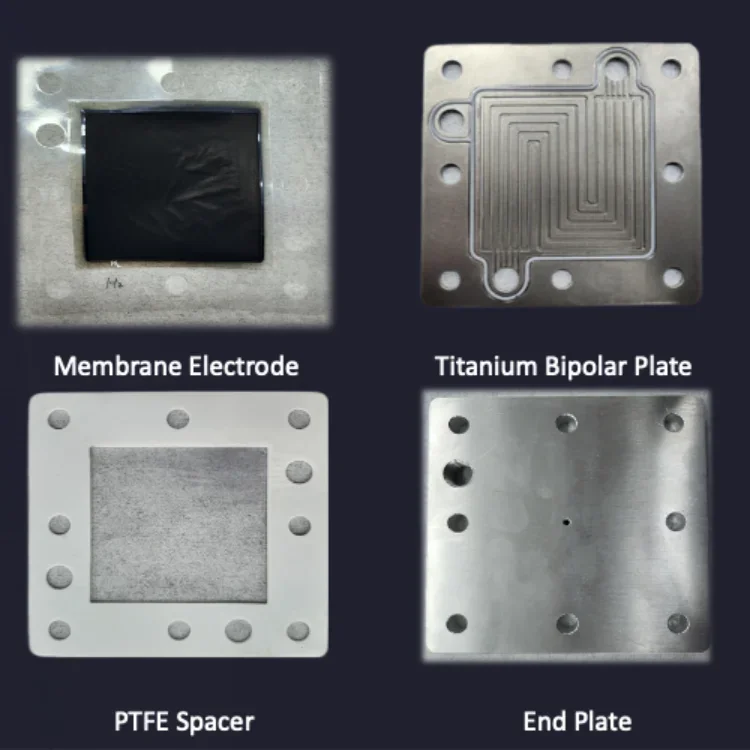In the realm of sustainable energy production, PEM electrolyzers stand out as key players. These devices utilize proton exchange membrane technology to split water into hydrogen and oxygen efficiently. By leveraging renewable energy sources, such as solar or wind power, PEM electrolyzers offer a clean and green solution for hydrogen generation. The versatility of these systems makes them ideal for various applications, including energy storage, fuel cells, and industrial processes. Stay tuned to explore the inner workings and benefits of PEM electrolyzers in revolutionizing the landscape of renewable energy.
Unveiling the Science of PEM Electrolysis
Process
PEM electrolysis, also known as Proton Exchange Membrane electrolysis, is a process that generates hydrogen and oxygen from water using electricity. This process involves two electrodes - an anode and a cathode - separated by a proton exchange membrane (PEM). When an electric current passes through the water, it triggers a reaction that splits water molecules into hydrogen and oxygen gases.
The anode attracts negatively charged ions (anions) like hydroxide ions (OH-) which then release oxygen gas (O2) while the cathode attracts positively charged ions (cations) like protons (H+) which combine to form hydrogen gas (H2). The PEM plays a crucial role in this process by allowing only protons to pass through while blocking other elements, ensuring the separation of hydrogen and oxygen.
Role
The Proton Exchange Membrane serves as a selective barrier that enables the passage of protons generated at the anode to reach the cathode. By facilitating this proton transfer, the membrane ensures that hydrogen gas is produced at one electrode while oxygen gas is produced at the other. This selective permeability of the membrane is essential for maintaining high purity in both gases.
Moreover, the PEM also prevents mixing of hydrogen and oxygen gases during production, minimizing safety risks associated with their recombination. Due to its critical function in separating gases and enabling efficient proton transport, choosing a high-quality PEM is vital for optimizing performance in PEM electrolyzers.
Efficiency
One key advantage of PEM electrolyzers lies in their efficiency in converting electrical energy into chemical energy stored in hydrogen gas. Compared to traditional alkaline electrolyzers, PEM electrolyzers operate at higher efficiencies due to lower activation energies required for reactions on platinum catalysts used at electrodes.
This increased efficiency results in faster response times and higher purity levels of generated gases. PEM electrolyzers can quickly ramp up or down their production rates based on demand fluctuations, making them ideal for applications requiring dynamic responses such as renewable energy integration or industrial processes needing variable hydrogen production levels.
Anode Reactions Explained
Oxidation Process
At the anode in a PEM electrolyzer, water molecules undergo an electrolysis reaction. This process involves the oxidation of water molecules into oxygen gas and positively charged hydrogen ions. The anode acts as the site where this crucial chemical transformation occurs.
The oxidation process at the anode is fundamental to splitting water molecules into their elemental components. As electricity passes through the electrolyte, it triggers a series of reactions that result in the release of oxygen gas at the anode. This step is essential for generating pure oxygen for various industrial applications.
Release of Oxygen Gas
During electrolysis, when water molecules are oxidized at the anode, they release oxygen gas as a byproduct. This released oxygen can be utilized in diverse sectors such as aerospace, healthcare, and environmental industries. The efficient production of high-purity oxygen gas hinges on optimizing the anode reactions within PEM electrolyzers.
-
Pros:
-
Efficient generation of pure oxygen gas
-
Versatile applications across different industries
-
Importance in Electrolysis
The significance of anode reactions in electrolysis cannot be overstated. These reactions play a pivotal role in driving the overall process of splitting water into hydrogen and oxygen gases efficiently. By understanding and controlling these reactions, researchers and engineers can enhance the performance and durability of PEM electrolyzers.
Cathode Reactions Demystified
Reduction Process
At the cathode, during the process of electrolysis, electrons are supplied. This leads to a reduction reaction where hydrogen ions (H+) gain electrons and turn into hydrogen gas (H2). The catalyst at the cathode helps facilitate this reaction efficiently.
The reduction process at the cathode is crucial as it drives the production of hydrogen gas, which is a clean and sustainable energy source. By utilizing electricity to split water molecules into hydrogen and oxygen, this process contributes significantly to green energy initiatives.
Generation of Hydrogen Gas
Through the catalytic action at the cathode, hydrogen gas is produced by combining with electrons from the external circuit. This generation of hydrogen gas plays a vital role in various sectors, including fuel cells for transportation and industrial applications.
-
Pros:
-
Efficient production of clean hydrogen gas.
-
Contribution to reducing carbon emissions.
-
Significance in Electrolysis
The significance of cathode reactions in electrolysis lies in their ability to drive key processes that result in valuable products like hydrogen gas. By harnessing these reactions effectively, industries can transition towards more sustainable practices while reducing their environmental impact.

Advantages of PEM Electrolyzers
Environmental Benefits
PEM electrolyzers offer significant environmental benefits, contributing to a cleaner and more sustainable future. By utilizing renewable energy sources, such as solar or wind power, these electrolyzers produce green hydrogen. This process helps reduce carbon emissions significantly, making it a crucial player in the fight against climate change.
The ability of PEM electrolyzers to operate efficiently at varying loads makes them ideal for integrating with renewable energy sources like solar and wind. This flexibility enables better grid management by storing excess renewable energy as hydrogen for later use during peak demand periods. The rapid response time of PEM electrolyzers allows for quick adjustments based on the fluctuating availability of renewable energy.
High Efficiency Levels
One of the key advantages of PEM electrolyzers is their high efficiency levels, surpassing traditional alkaline electrolysis methods. With efficiencies reaching up to 80%, these electrolyzers convert electrical energy into hydrogen with minimal losses. This high efficiency not only reduces operational costs but also maximizes the overall output of green hydrogen production.
In comparison to other types of electrolysers, such as alkaline electrolysers, PEM electrolysers boast a compact design that offers several advantages. The compact nature of PEM electrolysers allows for easy integration into existing infrastructure without requiring extensive space or modifications. This feature is particularly beneficial for applications where space is limited or where mobility is essential, such as in fuel cell vehicles or portable power generation units.
Understanding Voltage Losses
Definition of Voltage Losses
Voltage losses in PEM electrolyzers refer to the decrease in electrical efficiency due to various factors such as overpotential and ohmic losses. These losses impact the overall performance of the electrolyzer by affecting its ability to produce hydrogen efficiently.
Differentiating Overpotential and Ohmic Losses
-
Overpotential: It is the extra voltage needed to drive a reaction forward within the cell, leading to energy wastage.
-
Ohmic Losses: These occur due to resistance within the electrolyte or electrodes, converting electrical energy into heat instead of useful work.
When operating a PEM electrolyzer, understanding these distinctions is crucial for optimizing its performance. By minimizing both types of losses, operators can enhance the system's efficiency and reduce energy consumption significantly.
Impact on Electrolysis Efficiency
-
The presence of voltage losses directly influences the cell voltage, which is a critical parameter in determining an electrolyzer's efficiency.
-
Higher voltage losses result in increased electrical energy consumption, reducing the overall efficiency of hydrogen production.
-
This reduced efficiency not only affects operational costs but also impacts the environmental sustainability of hydrogen production processes.
To measure these losses accurately, operators often calculate the difference between theoretical cell voltages and actual values during operation. By analyzing these discrepancies, they can identify areas for improvement and implement strategies to minimize voltage losses effectively.

Ohmic Losses in Focus
Resistance-Related Losses
Ohmic losses occur due to the resistance encountered by the current densities within the electrolyzer. This resistance leads to a drop in voltage, impacting the overall efficiency of the system. The higher the current density, the greater the ohmic losses experienced.
To address these losses, manufacturers focus on reducing internal resistances through various means such as optimizing cell design and improving material conductivity. By enhancing conductivity, pem electrolyzers can operate at higher efficiencies, meeting emission reduction targets effectively.
Electrolyte Conductivity Role
Electrolyte conductivity plays a crucial role in determining the extent of ohmic losses within a pem electrolyzer. Higher conductivity results in lower resistive losses, allowing for more efficient operation at increased current levels. Manufacturers aim to utilize advanced materials with enhanced conductive properties to minimize these losses effectively.
One key factor influencing electrolyte conductivity is temperature. As temperatures rise, electrolytes tend to exhibit improved conductive behavior, leading to reduced internal resistances and subsequently lower ohmic losses. This highlights the importance of maintaining optimal operating conditions for enhanced performance.
Mitigating Strategies
To mitigate ohmic losses, researchers and manufacturers are exploring innovative strategies such as electrode surface modifications and novel catalyst materials. These approaches aim to enhance electron transfer rates across interfaces, thereby reducing resistive components within the system.
Moreover, optimizing operating conditions such as temperature and pressure can significantly impact internal resistances and subsequent voltage drops due to ohmic effects. By fine-tuning these parameters based on specific requirements, pem electrolyzers can achieve higher efficiencies while meeting stringent emission reduction goals effectively.
-
Pros
-
Enhanced efficiency
-
Improved performance metrics
-
Operating PEM Electrolyzer Systems
System Operation
PEM electrolyzers use a proton exchange membrane to split water into hydrogen and oxygen through an electrochemical process. The system requires a direct current power source to operate efficiently.
The process involves feeding water into the electrolyzer, where it undergoes electrolysis to produce hydrogen gas at the cathode and oxygen gas at the anode. The produced gases are then collected for various applications.
Maintenance Requirements
Regular maintenance is crucial for optimal performance of PEM electrolyzer systems. This includes monitoring and controlling operating parameters such as temperature, pressure, and flow rates to ensure stable operation.
Maintenance tasks involve checking and replacing the proton exchange membrane, electrodes, and other components periodically to prevent degradation and maintain high efficiency levels. Proper maintenance helps prolong the system's lifespan.
-
Pros: Efficient hydrogen production, environmentally friendly operation
-
Cons: High initial costs, regular maintenance requirements
Safety Protocols
Safety is paramount when operating PEM electrolyzers due to the presence of potentially hazardous gases like hydrogen and oxygen. Adequate ventilation in the operating area is essential to prevent gas buildup and minimize risks of explosions.
Operators must follow strict safety protocols when handling PEM electrolyzer systems, including wearing appropriate personal protective equipment (PPE) such as goggles, gloves, and lab coats. Regular training on emergency procedures is also necessary.
-
Ensure proper grounding of electrical components.
-
Implement leak detection systems for early gas leakage identification.

Summary
The intricate workings of PEM electrolyzers have been unveiled, shedding light on the underlying science behind anode and cathode reactions. The advantages they offer, coupled with insights into voltage losses and ohmic challenges, paint a comprehensive picture of operating PEM electrolyzer systems. As we navigate through the complexities of this technology, it becomes evident that the efficiency and potential for green hydrogen production are substantial.
With a deeper understanding of PEM electrolysis, exploring the realm of renewable energy sources becomes not only feasible but imperative for a sustainable future. Embracing these advancements in electrolyzer technology could pave the way for cleaner energy solutions on a global scale. It is time to harness the power of PEM electrolyzers and propel the world towards a greener tomorrow.
Frequently Asked Questions
What is a PEM electrolyzer?
A PEM electrolyzer is a device that uses a proton exchange membrane (PEM) to split water into hydrogen and oxygen through an electrochemical process.
How do anode reactions contribute to PEM electrolysis?
Anode reactions in PEM electrolysis involve the oxidation of water molecules, leading to the release of protons and electrons necessary for hydrogen production.
What are the advantages of using PEM electrolyzers?
PEM electrolyzers offer advantages such as high efficiency, fast response times, compact size, scalability, and the ability to operate at varying loads with minimal maintenance requirements.
What are ohmic losses in the context of PEM electrolysis?
Ohmic losses refer to the resistance encountered by ions passing through the proton exchange membrane in a PEM electrolyzer system, affecting its overall efficiency and performance.
How do operating conditions impact PEM electrolyzer systems?
Optimal operating conditions such as temperature control, pressure regulation, proper hydration levels within the membrane, and precise voltage settings are crucial for maximizing the efficiency and longevity of PEM electrolyzer systems.
